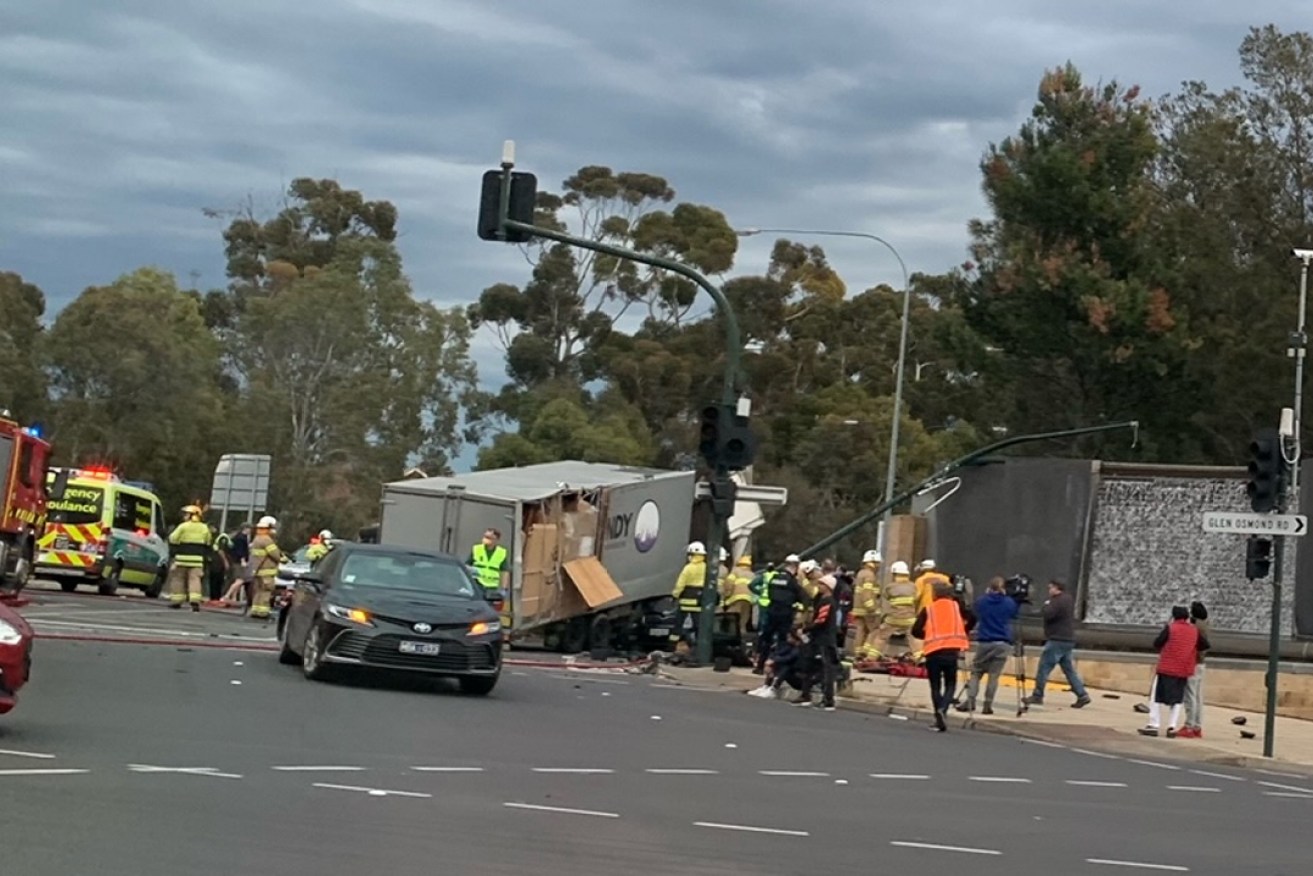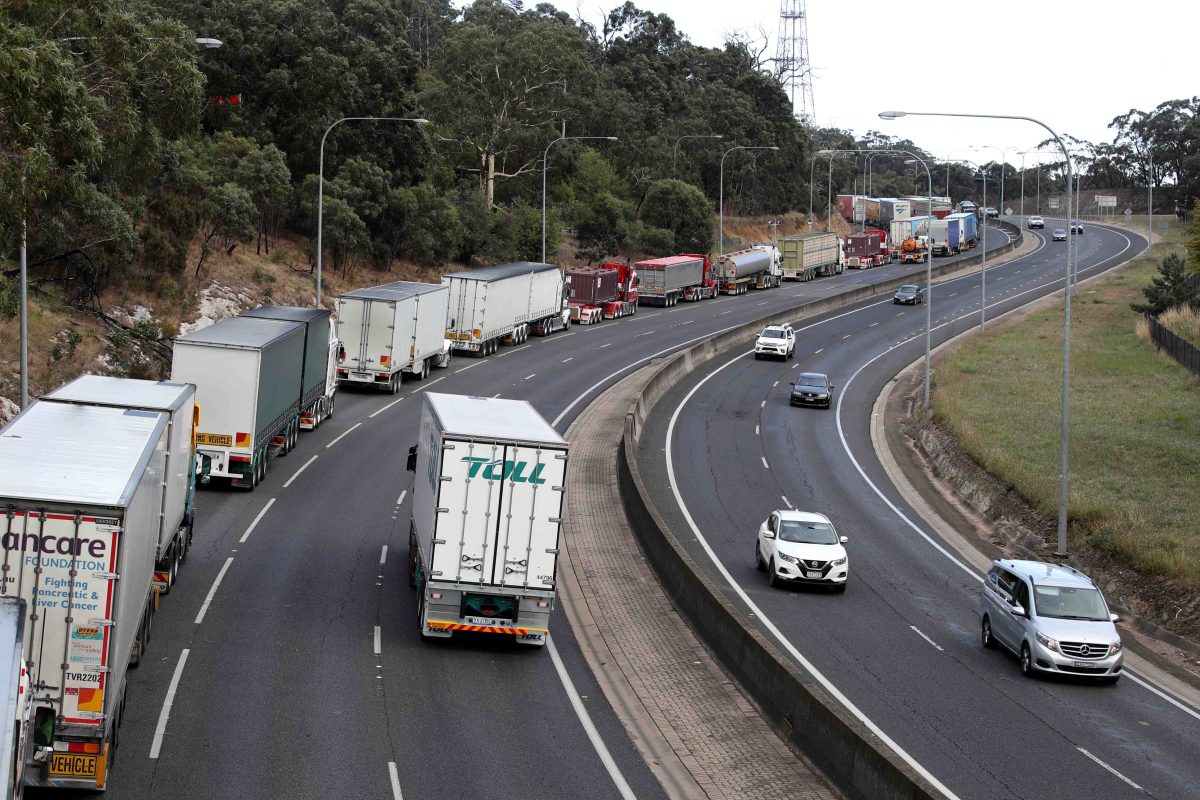40km/h freeway speed limit flagged in truck safety debate
UPDATED | Lower speed limits for all vehicles using the South Eastern Freeway downtrack have been flagged as a safety measure to be considered after the latest truck accident, with the State Government saying new limits could be introduced as early as October.

The scene after a truck hit cars at the SE Freeway bottom in July. Photo: Rebekah Clarkson
An industry roundtable discussion on the safety of the South Eastern Freeway looked at numerous solutions to safety concerns including a bypass and third arrester bed being built at the base of the freeway.
The State Government convened today’s discussion following a crash last month which saw nine hospitalised after a truck ploughed into cars waiting at the busy Cross Rd/Portrush Rd intersection.
It was the latest in a number of truck accidents at the freeway bottom, including one in 2014 where truck with no brakes hit cars and killed two people.
After meeting with representatives of road freight and heavy vehicle associations, SA Police and the RAA, Transport Minister Tom Koutsantonis said the government would examine changing freeway speed limits and that new limits could be introduced by October.
“If we change speed limits immediately for heavy vehicles that will automatically necessitate the use of different gearing ratios on vehicles, that could be enough to minimise that risk,” he said.
“The department will be modelling a change in speed limit. If we can do that quickly and safely, that is something I’ll be considering very, very quickly.”
But the RAA’s Charles Mountain said that imposing a 40km/h limit on trucks only would not increase safety if cars were still able to travel at the current maximum 90km/, and that a blanket lower limit should be considered.
“It has to be looked at, it certainly won’t be palatable for people who use the road on a regular basis, but at the end of the day, if you’re going to reduce heavy vehicles down to 40ks, you have to decide the safety elements if the adjacent traffic is traveling currently at what would be 50ks above that speed,” he said.
“That is something that will have to be discussed and worked through.”
SA Road Transport Association executive director Steve Shearer said the trucking industry had previously proposed a 40 km/h speed limit for trucks but government modelling ruled a change ineffective.
“They actually found the queue would back up past the arrester beds making it unsafe, but that’s going to be looked at again,” Shearer said.
“Nothing was finalised today. It really couldn’t be but I’m very, very positive that for the first time in 20 years, we’ve had a really good discussion, which is going to be continuing and we’ll get to a good package of solutions some short term some longer term.
‘We’ve got no problem with going slow down the hill. Most of us already do.”

Photo: AAP/Kelly Barnes
Koutsantonis said modelling for a decreased limit had proved ineffective in the past, but would be revisited.
“The long term solution I think everyone agrees on is we’ve got to educate drivers who are using a decline, how to how to navigate with decline safely,” he said.
“We can put it all the infrastructure we like. But in the end, this is a poorly designed road that only has one consequence if you’re not in the appropriate gear ratio, and that’s a catastrophic outcome unless you use an arrester bed.”
He said freeways safety issues were based mainly around smaller heavy vehicles and first time users.
“The freight industry and the trucking industry in South Australia overwhelmingly good corporate citizens, they know how to use this road and they use it exceptionally well,” he said.
Koutsantonis said the forum also ‘looked at’ the possibility of having trucks exclusively in one lane, and a bypass for trucks.
“We have talked about a bypass but the truth is a large part of the freight coming down the southeast freeway is local freight,” he said.
“A bypass is part of the solution, but it’s not the entire solution”
Koutsantonis said government transport officials would model a third arrester bed, but there were questions about its likely effectiveness.
“In my opinion and the department’s opinion is there are two [arrester beds] earlier up, they aren’t being used. Why is the third one more likely to be used?” he said.
“But then again, it’s all about minimising risks and giving people options at the last minute.”
The comments following the meeting suggested a 40 km/h limit might be considered for all vehicles, rather than just trucks, however, the Minister’s office later clarified that a specific lower limit for cars wasn’t discussed.
The 40 km/h limit for trucks would create the need for lower limits for other vehicles, although Shearer suggested that if such a measure was introduced it would likely lower the general limit from 90 km/h to 80.




